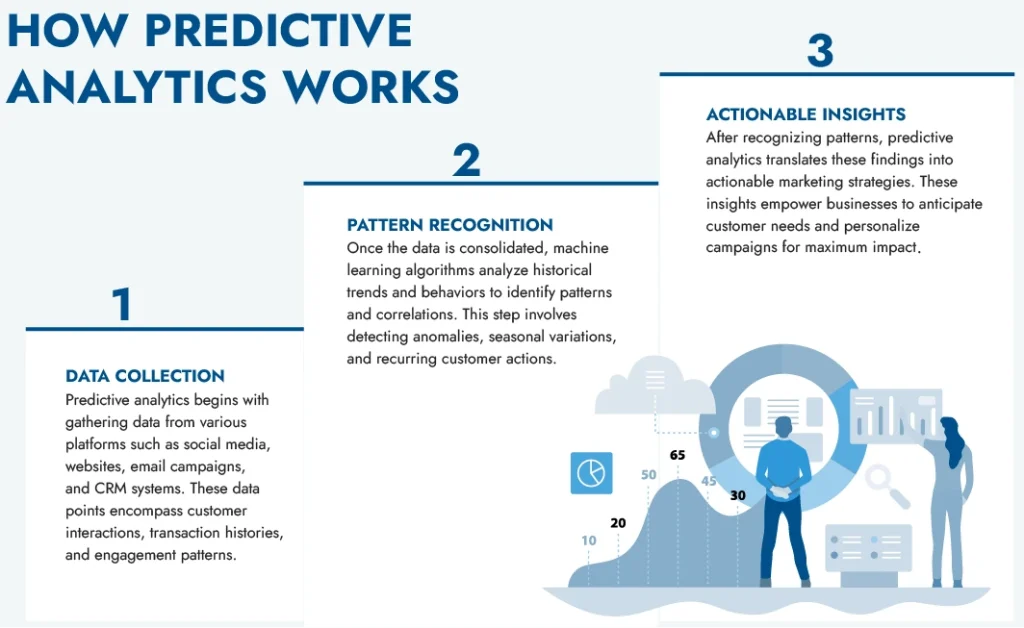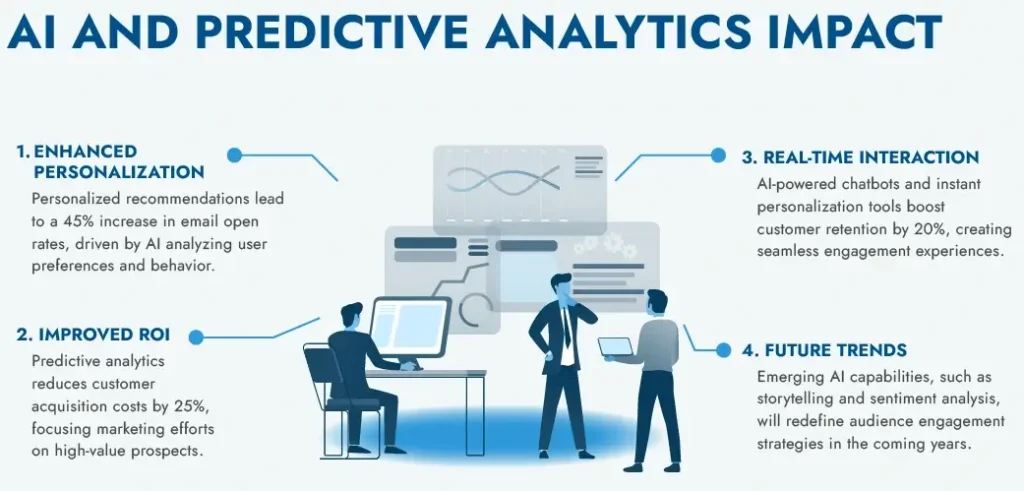


AI technologies are revolutionizing how businesses engage with their audiences, creating more personalized and effective customer experiences. From instant communication to tailored content delivery, these applications enable companies to maximize engagement and streamline operations. Below, we explore how some of these AI-powered tools work and their transformative impact on audience interactions.
Chatbots powered by AI deliver real-time, human-like responses to customer inquiries across various channels. These tools enhance engagement by providing immediate support, addressing questions, and even upselling products.
AI chatbots utilize natural language processing (NLP) to understand customer queries and generate appropriate responses. Advanced chatbots integrate with CRM systems, pulling customer data to personalize interactions further. For example, if a returning customer asks about order status, the chatbot can retrieve and share details instantly.
A retail website employs AI chatbots to handle frequently asked questions, such as product availability or return policies. By offering 24/7 support, the company reduces response time and boosts customer satisfaction.
AI recommendation engines analyze user behavior to suggest personalized content, products, or services. These tools enhance engagement by aligning offerings with individual preferences.
Recommendation engines use machine learning algorithms to analyze factors such as browsing history, purchase patterns, and interaction data. Collaborative filtering identifies similarities between users, while content-based filtering focuses on aligning suggestions with user-specific actions.
A streaming platform uses AI to recommend movies and shows based on a user’s viewing history. If a user watches several action movies, the engine highlights similar titles, keeping engagement high and reducing churn.
Dynamic ad placement leverages AI to ensure users see the right advertisements at the optimal time, maximizing ROI for campaigns. By analyzing user data, AI identifies which ads are most relevant to specific audience segments.
AI systems analyze factors like demographics, browsing behavior, and real-time engagement metrics to determine the best ad placements. Machine learning models dynamically allocate ad space, adjusting based on performance data to optimize effectiveness.
A digital marketing agency uses AI-powered ad placement to target users searching for vacation destinations. The system displays travel deals during peak interest periods, driving higher click-through rates and conversions.

AI ensures every interaction feels tailored, from email marketing to product recommendations.
Predictive analytics helps allocate resources efficiently, targeting campaigns where they’ll deliver the most impact.
AI enables immediate responses to customer actions, enhancing satisfaction and loyalty.

Data silos occur when data is scattered across different systems, departments, or platforms, making it difficult to consolidate and analyze comprehensively. This fragmentation can lead to inconsistencies, redundancy, and missed insights.
Businesses often store customer data in CRMs, financial data in ERPs, and operational data in separate systems. These isolated datasets limit the ability to derive actionable insights, as predictive models require a holistic view of data.
Implement unified data platforms that centralize all organizational data in one accessible location. Technologies such as data lakes and APIs can streamline integration, ensuring seamless connectivity between various systems. AI tools designed for data harmonization can also cleanse, deduplicate, and structure data, making it analysis-ready
Advanced AI models, while powerful, are often difficult to deploy and scale without specialized knowledge and infrastructure. Businesses struggle to build systems that cater to specific use cases, leading to inefficiencies.
Machine learning algorithms require significant computational resources and expertise in data science. Training these models on enterprise data can be time-intensive, and scalability becomes a concern as data volumes grow.
Collaborate with IT services providers to design custom AI solutions tailored to specific business needs. These providers can deploy scalable cloud-based machine learning platforms, reducing the burden of infrastructure setup. Pre-trained models can also be fine-tuned for specific applications, accelerating deployment and reducing development costs.
Data protection laws like GDPR impose stringent requirements on businesses handling personal data. Ensuring compliance while leveraging predictive analytics is a delicate balancing act.
Predictive analytics often involves processing large amounts of customer data, which raises concerns about privacy, transparency, and accountability. Non-compliance can result in hefty fines and reputational damage.
Implement robust compliance frameworks that incorporate data encryption, anonymization, and access controls. Regular audits of AI systems ensure adherence to regulatory standards. Advanced tools equipped with explainable AI features can provide transparency, showcasing how decisions are made while maintaining data security.

Enhanced Focus: Clearly defined objectives ensure the analytics process is aligned with business goals. For example, in reducing churn, data can be segmented to predict behaviors of high-risk customers.
Technological Strategy: Use advanced data visualization tools and AI-driven clustering algorithms to uncover patterns tied to your objectives. This allows businesses to refine marketing campaigns or customer outreach initiatives dynamically.


Strategic Insight: Custom platforms can be tailored with industry-specific algorithms, whether for retail, finance, or healthcare. For instance, a retail-focused platform might prioritize demand forecasting, while a financial tool could highlight fraud detection.
Technical Application: Opt for cloud-based predictive platforms capable of processing massive datasets in real time. API integrations should facilitate seamless data exchange between CRM, ERP, and analytical tools.

System Compatibility: Integrate AI systems with existing infrastructure like POS, inventory systems, or marketing automation tools to ensure uninterrupted operations.
Automation Impact: Utilize RPA (Robotic Process Automation) in tandem with AI to handle routine tasks like data entry, enabling predictive systems to focus on strategic decision-making.


Performance Monitoring: Leverage dashboards that provide real-time updates on metrics like conversion rates, customer acquisition costs, or lifetime value.
AI Feedback Loops: Employ machine learning techniques to refine predictive algorithms based on performance data, ensuring the system becomes more accurate over time.

Combining AI insights with creative content to deliver narratives that resonate deeply with audiences.
Leveraging AI to gauge customer emotions and refine engagement strategies.
Using predictive analytics to create seamless customer journeys across multiple touchpoints.


| Cookie | Duration | Description |
|---|---|---|
| __cf_bm | 1 hour | This cookie, set by Cloudflare, is used to support Cloudflare Bot Management. |
| _cfuvid | session | Calendly sets this cookie to track users across sessions to optimize user experience by maintaining session consistency and providing personalized services |
| cookielawinfo-checkbox-advertisement | 1 year | Set by the GDPR Cookie Consent plugin, this cookie records the user consent for the cookies in the "Advertisement" category. |
| cookielawinfo-checkbox-analytics | 11 months | This cookie is set by GDPR Cookie Consent plugin. The cookie is used to store the user consent for the cookies in the category "Analytics". |
| cookielawinfo-checkbox-functional | 11 months | The cookie is set by GDPR cookie consent to record the user consent for the cookies in the category "Functional". |
| cookielawinfo-checkbox-necessary | 11 months | This cookie is set by GDPR Cookie Consent plugin. The cookies is used to store the user consent for the cookies in the category "Necessary". |
| cookielawinfo-checkbox-others | 11 months | This cookie is set by GDPR Cookie Consent plugin. The cookie is used to store the user consent for the cookies in the category "Other. |
| cookielawinfo-checkbox-performance | 11 months | This cookie is set by GDPR Cookie Consent plugin. The cookie is used to store the user consent for the cookies in the category "Performance". |
| CookieLawInfoConsent | 1 year | CookieYes sets this cookie to record the default button state of the corresponding category and the status of CCPA. It works only in coordination with the primary cookie. |
| viewed_cookie_policy | 11 months | The cookie is set by the GDPR Cookie Consent plugin and is used to store whether or not user has consented to the use of cookies. It does not store any personal data. |
| wpEmojiSettingsSupports | session | WordPress sets this cookie when a user interacts with emojis on a WordPress site. It helps determine if the user's browser can display emojis properly. |
| Cookie | Duration | Description |
|---|---|---|
| li_gc | 6 months | Linkedin set this cookie for storing visitor's consent regarding using cookies for non-essential purposes. |
| lidc | 1 day | LinkedIn sets the lidc cookie to facilitate data center selection. |
| wp-wpml_current_language | session | WordPress multilingual plugin sets this cookie to store the current language/language settings. |
| yt-remote-cast-installed | session | The yt-remote-cast-installed cookie is used to store the user's video player preferences using embedded YouTube video. |
| yt-remote-connected-devices | never | YouTube sets this cookie to store the user's video preferences using embedded YouTube videos. |
| yt-remote-device-id | never | YouTube sets this cookie to store the user's video preferences using embedded YouTube videos. |
| yt-remote-fast-check-period | session | The yt-remote-fast-check-period cookie is used by YouTube to store the user's video player preferences for embedded YouTube videos. |
| yt-remote-session-app | session | The yt-remote-session-app cookie is used by YouTube to store user preferences and information about the interface of the embedded YouTube video player. |
| yt-remote-session-name | session | The yt-remote-session-name cookie is used by YouTube to store the user's video player preferences using embedded YouTube video. |
| ytidb::LAST_RESULT_ENTRY_KEY | never | The cookie ytidb::LAST_RESULT_ENTRY_KEY is used by YouTube to store the last search result entry that was clicked by the user. This information is used to improve the user experience by providing more relevant search results in the future. |
| Cookie | Duration | Description |
|---|---|---|
| _ga | 1 year 1 month 4 days | Google Analytics sets this cookie to calculate visitor, session and campaign data and track site usage for the site's analytics report. The cookie stores information anonymously and assigns a randomly generated number to recognise unique visitors. |
| _ga_* | 1 year 1 month 4 days | Google Analytics sets this cookie to store and count page views. |
| _gcl_au | 3 months | Google Tag Manager sets the cookie to experiment advertisement efficiency of websites using their services. |
| _li_id | 2 year | Leadinfo places two cookies that only provides Eastern Enterprise insights into the behaviour on the website. These cookies will not be shared with other parties. |
| Cookie | Duration | Description |
|---|---|---|
| bcookie | 1 year | LinkedIn sets this cookie from LinkedIn share buttons and ad tags to recognize browser IDs. |
| guest_id | 1 year 1 month | Twitter sets this cookie to identify and track the website visitor. It registers if a user is signed in to the Twitter platform and collects information about ad preferences. |
| test_cookie | 15 minutes | doubleclick.net sets this cookie to determine if the user's browser supports cookies. |
| VISITOR_INFO1_LIVE | 6 months | YouTube sets this cookie to measure bandwidth, determining whether the user gets the new or old player interface. |
| VISITOR_PRIVACY_METADATA | 6 months | YouTube sets this cookie to store the user's cookie consent state for the current domain. |
| YSC | session | Youtube sets this cookie to track the views of embedded videos on Youtube pages. |
| yt.innertube::nextId | never | YouTube sets this cookie to register a unique ID to store data on what videos from YouTube the user has seen. |
| yt.innertube::requests | never | YouTube sets this cookie to register a unique ID to store data on what videos from YouTube the user has seen. |
| Cookie | Duration | Description |
|---|---|---|
| __Secure-ROLLOUT_TOKEN | 6 months | Description is currently not available. |
